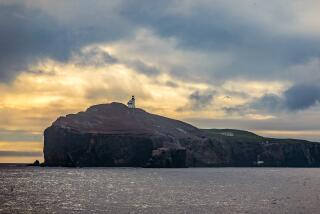By Bike Through Canada’s Iles-de-la-Madeleine
- Share via
CAP-AUX-MEULES, Canada — Iles-de-la-Madeleine. The name conjures up images of beauty and gentleness. And this remote 12-island archipelago 50 miles into the Gulf of St. Lawrence in easternmost Quebec lives up to its romantic name.
Here are no hotel chains, no crowds and no crime--only miles of sand dunes that interlace many of the islands and create calm inland lagoons.
In summer, the hills are strewn with wild berries. Richly painted frame houses look to the open sea.
Most of the islands’ 15,000 inhabitants, known as Madelinots, are the French-speaking descendants of farmers and fishermen who settled the area in the 17th Century. Roads on the natural dune bridges make touring the islands a breeze, by bus, car, or--as we did--by bicycle.
From Cap-aux-Meules, we took daily excursions with 10 other cyclists, ages 30 to 50. We averaged 35 miles a day, the easy pace and terrain making it comfortable for all of us.
The bicycle package included a number of extra activities, such as a theatrical performance, evenings of jazz and island folk songs, horseback riding on the beach and a plane ride over the islands.
But cycling was our mainstay. We saw the wooden sculpture commemorating Jacques Cartier’s arrival in the islands in 1534, and St. Peter’s By the Sea Church--an Anglican building framed from the wood of the shipwreck “Cargo.”
Our guides from Sunset Bicyle Tours pointed out the experimental windmills on Havre-aux-Maisons (they looked like eggbeaters), and on Havre Aubert we visited the charming Museum of the Sea, with its history of the islands and their inhabitants.
We looked into some shops, too, such as Francois Turbide’s, where he practices the art of glass blowing, or one on Havre Aubert that featured items sculpted in sand from island beaches. A favorite was a quaint boutique with a sandy floor and a window to the sea carved in the fragile red sandstone bluffs.
We were always near the water. The open sea, bays and lagoons provided ideal conditions for swimming and other water sports. We noticed a school where beginners could take up windsurfing. Best of all were the beaches--white, wide and strewn only with shells brought in by the tide. Cliffs shelter the beautiful Dune du Sud beach, where, we were told, at low tide one can explore caves along the shoreline.
The dunes make a playground of Plage de la Grande Echouerie on Grosse Ile, also one of the best sites for view seals. We followed the beach to a point called Old Harry, where Europeans founded a walrus-hunting station and established a Continental presence on the island.
Acadian farmers and fishermen eventually colonized the archipelago. The first Europeans to explore and lay claim to the St. Lawrence River, the French protected the region around the river’s entrance. They called the land to the south of the Gulf of St. Lawrence, known today as Nova Scotia and New Brunswick, Acadie.
Afterward, its position made Acadie a strategic point in the ensuing struggle between the English and French for control of the waterway. Wishing only to farm, fish and live peacefully with the friendly Micmac Indians, the Acadians were not involved in the war. Still, the English demanded that they pledge allegiance to England or suffer exile.
Some escaped to the north; others who had come from Saint-Pierre and Miquelon, now Newfoundland, began life anew in the Iles-de-la-Madeleine.
Nearly all of the islands’ inhabitants speak French today.
On the outer island of Ile d’Entree, however, the common language is English. We took the 45-minute ferry ride from Cap-aux-Meules to visit the colony of 200 fishermen and their families. It was like discovering yet another new land. We followed footpaths through the fragrant fields of irises and wild roses that encircle the tiny isle. It was difficult to grasp the harsh and isolated lives that these islanders lead, but easy to sense the freedom that they love.
The Madelinots are warm and gracious hosts. Many open their homes to visitors, renting out rooms and cottages, but only one place on Ile d’Entree offers room and board, so anyone wishing to stay the night should make early reservation. We found the accommodations on the other islands, and the meals of fresh seafood, uniformly first-class. La Table des Roy, La Maison de Rosee and L’Hotel au Vieux Couvent combine atmosphere with exquisite French cuisine that would rival any big-city restaurant.
“Pot-en-pot” and bouillabaisse are regional seafood dishes, and lobster is an affordable luxury here--only $7 at the Cooperative de Gros-Cap.
More to Read
Sign up for The Wild
We’ll help you find the best places to hike, bike and run, as well as the perfect silent spots for meditation and yoga.
You may occasionally receive promotional content from the Los Angeles Times.




